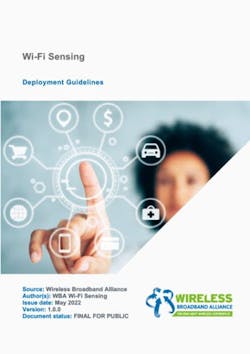
The Wireless Broadband Alliance (WBA) has this month announced the publication of its “Wi-Fi Sensing — Deployment Guidelines,” as the latest document in a series of white papers designed to help the industry, WBA members and a wide range of enterprises in different vertical industries understand the technology, its use cases, market opportunities and more.
As described by the consortium, "Wi-Fi Sensing is a new and rapidly developing technology that aims to revolutionize how people use Wi-Fi networks around the world. Wi-Fi Sensing leverages existing Wi-Fi signals to sense motion, enabling a suite of new applications and revenue streams in markets such as home security, caregiving, enterprise, small business, and hospitality."
The WBA further notes that Wi-Fi Sensing technology "enables Wi-Fi networks to become more interactive, apply new levels of automation, and unearth meaningful new user benefits from broadband services, like convenience, peace of mind, health insights, and privacy. Wi-Fi is a previously untapped source of artificial intelligence for preventative and analytics-driven solutions that could redefine our concept of the 'smart' home," contends the consortium.
Tiago Rodrigues, CEO of the Wireless Broadband Alliance, commented: “Wi-Fi Sensing lays the foundation for Wi-Fi service providers to expand into a wide variety of exciting new markets, including health care, home security, building automation and more. ‘Wi-Fi Sensing — Deployment Guidelines’ is the latest example of the WBA’s commitment to providing the marketplace with guidance for developing and deploying innovative Sensing solutions.”
The guidelines white paper focuses on residential applications in single-family homes and multi-dwelling units. The paper covers key topics surrounding the technology, such as:
- Technological benefits, relevant communication guidelines and constraints.
- Environmental and device factors that can impact sensing, such as how different types of construction materials affect signal strength and propagation in each Wi-Fi band.
- Experiments that provide insights into factors such as access point locations, interference, floor plans, etc.
- General deployment guidelines, including access point placement, network topology, floorplan considerations and sensitivity settings.
Sandeep Agrawal, Wi-Fi Sensing project co-lead, concluded, “The Wi-Fi Sensing Project group has worked over last three years to bring comprehensive white papers around Wi-Fi Sensing technology including its testing, measurement and deployment aspect of this technology. The papers will supplement the broader community of standardization activities, technology and product development.”